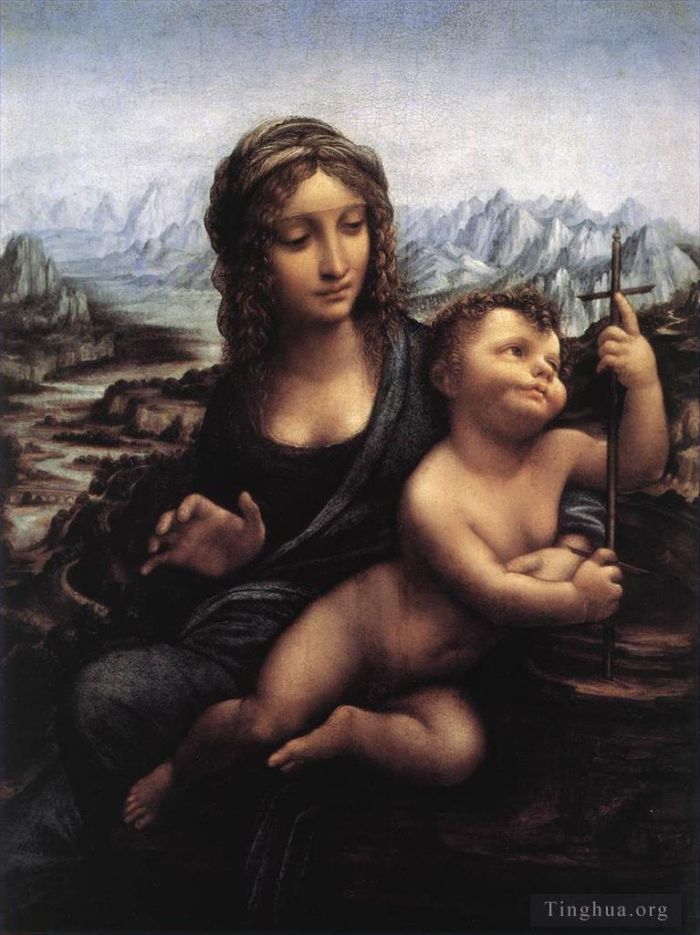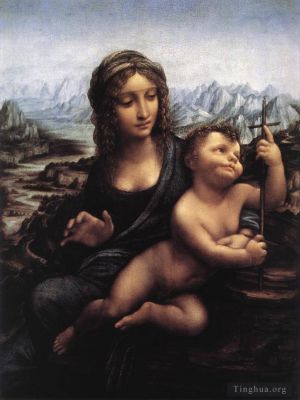Madonna with the Yarnwinder after 1510
Leonardo da Vinci
- Price:
- Art Type: Oil Painting
- Size:
- English Comments: 0
- International Comments: 0
- Creating Date:
- Introduction and Works of Leonardo da Vinci >>
Keywords:
Madonna, Yarnwinder
Work Overview
- Artist Attributed to Leonardo da Vinci and another artist
Type Oil on walnut
Dimensions 48.3 cm × 36.9 cm (19.0 in × 14.5 in)
Location Scottish National Gallery, Edinburgh (on long-term loan from the Duke of Buccleuch’s collection)
Owner Richard Scott, 10th Duke of Buccleuch
The composition of the Madonna of the Yarnwinder shows the Christ child twisting his body away from his mother’s embrace, his eye caught by her yarnwinder whose spokes give it the shape of a cross; he precociously recognises it as a symbol of his destiny. The Virgin’s reaction is ambiguous, a mixture of alarm at the harm her son will come to and resigned acceptance of it. The gesture of suspense made with her right hand is repeated from Leonardo’s Milanese altarpiece The Virgin of the Rocks. The use of a symbol of the Passion as an object of childish play recurs throughout Leonardo’s painted oeuvre, appearing for instance in the Benois Madonna and the Virgin and Child with St Anne.[3] As with later works by Leonardo, the figures appear in a vast unpopulated landscape. The rocky outcrop in the foreground of the Buccleuch Madonna is painted with a minute attention to geological detail.
A major difference between the Buccleuch and Lansdowne Madonnas is in their background landscapes. Whereas the background of the Buccleuch version is a watery landscape indifferently painted, that of the Lansdowne Madonna has a dramatic mountain range far more typical of Leonardo. It has been proposed that this is a specific location in the valley of the river Adda, as it runs from Lecco to Vaprio, an area familiar to Leonardo and which he mapped.[8] It is possible that the landscape of the former picture was added by a pupil after Leonardo failed to complete the work.[9] For Martin Kemp the “late” character of the landscape in the Lansdowne Madonna suggests that it was the later painting to be completed and that the Buccleuch Madonna was the one sent to Robertet in 1507.[10]
The underdrawings of both the Buccleuch and Lansdowne Madonnas show several features not in the finished works, but present in some copies; it is likely that these were originally copied from the prime versions during an early stage of the composition’s development. One such feature, which appears in both underdrawings, is a group of figures identified as St Joseph making a baby walker for the Christ child, who appears with his mother[11] and another female figure, probably a midwife.[12] It has also been suggested that the child learning to walk is the infant John the Baptist, appearing with his mother St Elizabeth, as Leonardo would have been unlikely to depict the figures of Mary and Christ twice in the same painting.[13] Leonardo also experimented with including some kind of beast of burden – a horse, ass or ox – which appears in different positions in the two underdrawings. Behind these an architectural structure with an arched opening was planned. At a later stage the landscape of the Buccleuch picture seems to have had a bridge like that of the Lansdowne Madonna, which was then painted over.
Buccleuch Madonna[edit]
The version of this painting often regarded as the most likely to be by Leonardo is now in the Scottish National Gallery in Edinburgh, on loan from the Duke of Buccleuch. It hung in his ancestral home in Drumlanrig Castle, Dumfries and Galloway, Scotland, until it was stolen in 2003. It entered the Buccleuch collection in 1767, with the marriage of the 3rd Duke to Lady Elizabeth Montagu, the heiress to a substantial collection of works assembled by her parents, the Duke and Duchess of Montagu. This Madonna of the Yarnwinder was bought at auction in Paris in 1756 from a sale of the collection of Marie-Joseph duc d’Hostun et de Tallard, its earliest documented owner.[15]
Theft and recovery[edit]
In 2003 the Buccleuch Madonna was stolen from Drumlanrig Castle by two thieves posing as tourists, who said "Don't worry love, we're the police. This is just practice" to two tourists from New Zealand as they exited through a window carrying the Leonardo.[16] In 2007 a chartered loss adjuster acting for the Duke of Buccleuch’s insurers was contacted by an English lawyer, who claimed that he could arrange for the painting’s return within 72 hours. The lawyer, Marshall Ronald of Skelmersdale, Lancashire, was visited by two undercover policemen who posed as an art expert and an agent for the Duke. The painting was then taken to a lawyer’s office in Glasgow;[17] this was raided by police officers from four anti-crime agencies during a meeting of five people. Four arrests were made, including of two solicitors from different firms. The Scotsman, describing the Glasgow firm as "one of the country's most successful and respected law firms", quoted a source as saying their arrested member "was not involved in any criminal act, but was acting as a go-between for two parties by scrutinizing a contract which would have allowed an English firm to 'secure legal repatriation' of the painting from an unidentified party."[18][19][20]
The 9th Duke of Buccleuch never lived to see the Madonna's recovery as he had died unexpectedly only a month beforehand.[21] The painting was lent to the National Gallery of Scotland (now the Scottish National Gallery) in Edinburgh in 2009,[22] and remains on display there as of 2017. In 2010 Ronald was cleared of the charge of holding the Duke to ransom; in 2013 he mounted legal action against the 10th Duke and the Chief Constable of Dumfries and Galloway, demanding a reward of £4.25 million, which he claims he was promised in the meeting with the undercover policemen six years earlier.
The painting sometimes considered the second prime version of the Madonna of the Yarnwinder takes its name from the Marquesses of Lansdowne, who owned it in the 19th century. John Henry Petty, then Earl Wycombe and later the 2nd Marquess of Lansdowne, bought it some time in or before 1809, possibly from the Earl of Darnley.[23] It is first recorded in a sale of the Dowager Marchioness of Lansdowne’s collection in 1833, from which it was withdrawn.[24] The painting remained in her family until 1879, when her daughter sold it to Cyril Flower, later Lord Battersea.[25] In 1908 the Madonna was bought from his widow by the Paris-based art dealers Nathan Wildenstein and René Gimpel. They consulted Bernard Berenson, the leading connoisseur of the day, on the attribution in 1909; he confirmed an earlier attribution to il Sodoma but thought that Leonardo had been responsible up to the cartoon stage.[26] During restoration work in around 1911 the painting was transferred to canvas and several alterations were made, most significantly the removal of a loincloth covering the Child’s genitals and the fingers of the Virgin’s left hand.[27]
The painting was bought as a Sodoma in 1928 by Robert Wilson Reford, a Canadian industrialist and shipping magnate.[28] In the 1930s it underwent X-ray and ultraviolet examination for the first time, led by a team which included the art historian Wilhelm Suida.[27] He concluded that the Christ child and the landscape were by Leonardo and the remainder was by a Milanese pupil.[29] During a loan to the New York World’s Fair in 1939 the painting was damaged and further restoration work had to be undertaken.[30] Reford’s family put it up for auction in 1972, but by then the attribution had reverted to Sodoma, inevitably resulting in a lower price than had it been accepted as a Leonardo. It was bought back by Wildenstein & Company, who arranged for it to be transferred a second time, this time onto a composite panel, in 1976.[31] They sold the Madonna (as a Leonardo) to its current owner, an anonymous private collector, in 1999.
Nearly forty versions of the Madonna of the Yarnwinder made by pupils and followers of Leonardo survive today.[33] Many show elements which were discarded as the prime version, or versions, evolved over a long period of time. Some include the figure group in the middle ground visible in the Buccleuch and Lansdowne underdrawings; others show the basket of wool described by Fra Pietro da Novellara, though to Christ’s side rather than beneath his foot. Eight paintings, including the copy in the Louvre, show a different kind of rocky outcrop in the foreground from those in the prime versions; many of these are probably by Lombard Leonardeschi.[34] Some artists elaborated on Leonardo’s composition with the addition of still lives or extra figures.[35]
The Madonna of the Yarnwinder’s composition was especially popular in Spain, where it might have been brought over by Fernando Yáñez de la Almedina or Hernando de los Llanos (whose name also appears as Fernando de Llanos). Both painters were trained in Florence in the first years of the 16th century, and either might be the “Ferrando spagnolo” mentioned as a pupil of Leonardo when the master was working on the fresco of the Battle of Anghiari in the Palazzo della Signoria in 1505.
- Copyright Statement:
All the reproduction of any forms about this work unauthorized by Singing Palette including images, texts and so on will be deemed to be violating the Copyright Laws.
To cite this webpage, please link back here.
- >> English Comments
- >> Chinese Comments
- >> French Comments
- >> German Comments
- >>Report
- Leda 1508
- Portrait of a musician
- The Virgin of the Rocks 1491
- Madonna and Child with Flowers (Benois Madonna)
- The Annunciation
- Madonna and Child with a Pomegranate
- Portrait of Ginevra Benci
- La belle Ferroniere
- Baptism of Christ
- St John the Baptist
- St John in the Wilderness (Bacchus)
- Madonna Litta
- Leda 1530
- The Virgin and Child with St Anne
- Madonna with the Yarnwinder 1501
- Madonna with the Yarnwinder after 1510
- Saint Jerome
- Leda 1510
- Portrait of Cecilia Gallerani (Lady with an Ermine)
- Leda and the Swan 1505
- The Madonna of the Carnation
- Mona Lisa
- Vitruvian Man
- Design for St Anne
- Study of a womans head
- Allegory with wolf and eagle
- Battle of Anghiari Tavola Doria
- Study of a rider
- Study for the Last Supper Judas
- Rearing horse
- Study sheet with horses and dragons
- Madonna and Child with St Anne and the Young St John detail1
- Studies of human skull
- Study for Madonna and Child with St Anne Drapery over the legs
- Study of hands
- Anatomical studies of the shoulder
- Star of Bethlehem and other plants
- Battle of Anghiari
- Drawing of the Torso and the Arms
- Adoration of the Magi
- Study of St Anne Mary and the Christ Child
- Ceiling decoration
- Study of horses
- Studies of Leda and a horse
- Womans Head
- Study for the Last Supper
- The Last Supper
- Landscape drawing for Santa Maria della Neve on 5th August 1473









 Singing Palette
Singing Palette